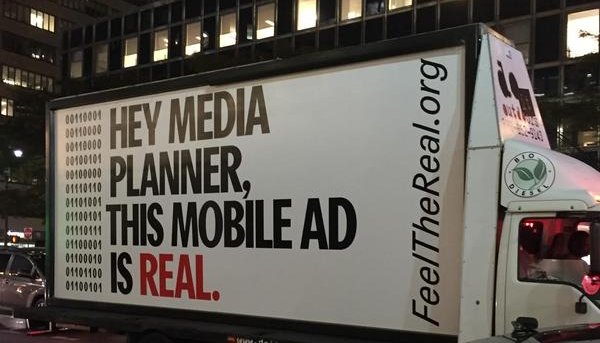It might sound crazy to claim an ad campaign covered by The Wall Street Journal didn’t get enough attention. But it sure seems that way to me, for the recent and ongoing out-of-home “Feel the Real” campaign from the Outdoor Advertising Association of America.
“Feel the Real” is great advertising. Smart, straightforward, and effective use of the medium it touts to prove its primary point. On top of that, its timing couldn’t be more relevant, as the drumbeats quicken over concerns about Adblocking in the digital marketing space, suddenly even more urgent an issue than ads boosted by bot-views, near-hidden ad placements, and other inventive ways to digitally defraud.
Most admirably, “Feel the Real” follows what I consider the First Commandment of Advertising, laid down by its most wise high priest, David Ogilvy: The best advertising is truth well told.
And “Feel the Real” is most certainly truth well told. Its message is an undeniable truth, and self-evident. Out-of-Home (OOH) billboards, with simple words in black and white and sometimes red, state the obvious: “This ad is real. You are consuming an advertisement. You are real.”
Even a decade ago, that might have sounded absurdly meta, written by a copywriter while dropping acid. But in today’s too loose wild west of increasingly digital-driven marketing, it’s actually a call to arms and action.
Now, admittedly, I’ve got a dog in this fight—but I’m proud of the dog and see no reason to hide it. Our business, Wrapify, is going all-in on the OOH advertising market, and it is exactly because what our platform offers is real and tangible that we have seen such immediate acceptance and have already blown past our most optimistic projections for 2015.
So I cite Wrapify’s success not in self-promotion, but as corroboration of the outdoor medium’s resilient vitality—as well as validation of its current marketing by the Association that is supposed to best represent it. So, good job OAAA, and thank you!
But I’d like to help them out, too. The OAAA plays nice, saying that the best OOH campaigns work in conjunction with a digital experience, but they do point out that half of all digital advertising spending is wasted.
That’s a fact that can’t be said loud enough to the industry, even if the Association is too polite to scream it while banging a drum. They won’t quote the Fortune story that flat out stated digital advertising “Fraud is rampant.” But I’ll do it for them.
61.5% of web traffic is not human. 100% of #OOH traffic is human. #feelthereal ow.ly/SL23N pic.twitter.com/48ucPSkTjS
Everyone in marketing needs to get this through their head, even though it’s tough to wrap the mind around it. Half your digital spend is wasted. Half. Wasted.
Recently, Google admitted that 56% of ads are never seen. ComScore says 46%. Split the difference and we’re still at half.
It’s funny how all the old truths, stay true, just reinvented. The great early mass retailer John Wannamaker famously said, “Half my money spent on advertising is wasted,” and he was right. But he also said “The trouble is, I don’t know which half.” Well, now we know. You’re wasting it on digital advertising.
$7 billion down the virtual drain honestly blows my mind, and I’m not sure how any brand CMO can justify it. There may genuinely be a level of denial, or institutional denial. But the truth is that the amount of money being wasted on digital marketing is positively absurd. It’s going to stop, at least a few billion of it, and that money is going to flow elsewhere.
The OOH market will almost certainly get a lot of it. The shift to OOH makes sense historically from a mass human behavioral perspective, applied to business: As new technologies are revealed to be not the salvation they were prophesied to be, there will be a retreat to the proven and true, the empirical, the real. And, as we’ve heard, with OOH, you can “Feel the Real.”
That is not to dismiss digital or technology. But people too should recall the futility of technology simply for technology’s sake, to prove “it can be done.” Smart technology is sometimes best used to build even better mousetraps for ideas already proven to work.
That’s what Wrapify offers. We’ve taken a rather old school way of marketing, wrapped vehicles, and added crowd-sourcing, the sharing economy, proprietary technology, and analytics, for a revolutionary OOH platform that deals a winning hand for everyone involved: Drivers, brands, the marketing experience.
Ordinary everyday drivers can pick the brand they want to partner with, get their cars wrapped in a day or less, then get paid regularly by the mile though a unique mobile application that tracks their movements. Brands get real-time visualized dashboards of cars’ impressions, so they know how many people are seeing them.
Wrapify has the impression numbers to prove OOH works. To share but one campaign, for the national retailer Petco, Wrapify put five cars on the road in San Francisco for two months and received 3.2 million impressions. That’s more than billboards in the region receive.
We see a very vibrant and lucrative future for the outdoor industry, and look forward to be a revolutionary part of it. Wrapify believes in the “Feel the Real” campaign, because we know it to be true, and applaud the OAAA for this strong and eternally valid campaign.
